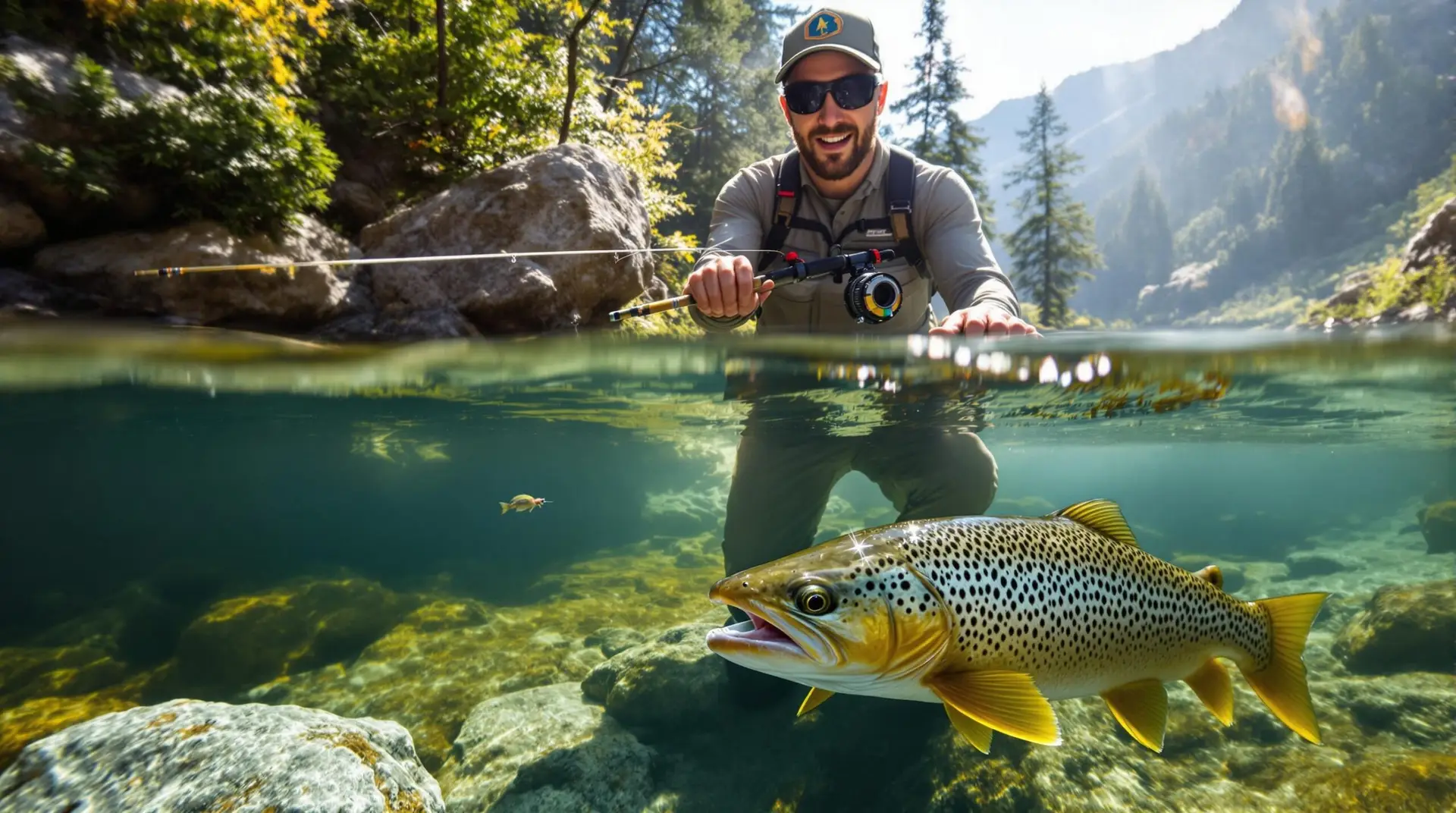Nymph Fishing Essentials
Understanding Nymph Fishing
Nymph fishing brings a unique twist to fly fishing; think of it as sneaky fishing! While dry fly lovers focus on the surface, nymph anglers aim to catch trout below the water, using clever imitations of underwater critters—like bugs, crustaceans, or squiggling worms. Get to know your bugs—their stages and hangout spots, which are usually around rocks or hidden place. If your fly box is bursting with flashy, neutral, or European-style nymphs, you’re on the right path to convincing trout to bite.
Feast your eyes on these common fly choices:
| Fly Pattern | Appearance | Stage |
|---|---|---|
| European Nymph | Slim, weighted | Larval/Subsurface |
| Classic Nymph | Natural shades, detailed | Larval/Subsurface |
| Flashy Attractor | Bright hues, added shine | Subsurface |
| Natural Imitation | Earth tones, lifelike movement | Subsurface |
Why Nymph Fishing Works Wonders
Nymph fishing is like hitting the trout jackpot. Stealthy and effective, it aligns with how trout think—or eat. Most of the time, these fish are munching below the water’s surface, which means placing your bait here is a smart move.
Here’s why nymph fishing rocks:
- What Trout Love: They feast on those underwater bugs, so tossing a nymph their way just makes sense.
- Natural Drift: Nymphing lets your lure sway like the real deal—a bug caught in the current.
- Fly Sampler: Offering a choice array of nymphs caters to a trout’s seemingly picky appetite.
If you’re hooked on this and want to learn even more, check out the advanced take on euro nymphing here.
The trick with nymphs is nailing the setup—good weighting, proper rigging, and understanding depth are your allies. To get the scoop on setting up, check out the nymph rig weight placement guide or spy on how to do a perfect nymphing leader setup. 😉
Advanced Sight Nymphing Techniques
Trout Feeding Behavior
Getting to grips with how trout chow down is the golden ticket to ace sight nymphing. Forget the dry fly gig, where you’re making like a grown-up bug skating on top of the water. We’re diving deeper in the realm of nymph fishing, where you’re mimicking the secret life of bugs lurking below—in the crannies and beneath stones (Orvis).
Trout mostly munch beneath the surface. So, it’s up to us fish chasers to bring the enticing bugs to them and mirror their diet. Having a well-stocked fly box with dependable nymphs and wet fly options, including European-themed nymphs, age-old favorites, eye-catching attractors, and natural nymph replicas, ups your game big time.
Sun Positioning and Sight Nymphing
Where the sun’s at is a big deal when it comes to sight nymphing. The sun’s angle decides how sharp the trout’s vision is. If they’re squinting into the sun, odds are, their view’s pretty limited, which changes where they snap up their snacks from (Fly Fisherman).
To nail sun positioning:
- Fish on the side with killer views for the trout—make sure your nymph is spotlighted.
- Keep your shadows off the water unless you want your fish to bolt.
- Track the sun’s angle as it moves through the day, and shuffle your spot as needed.
Movement Cues and Strike Timing
Tuning into your trout’s body language gets you those perfect strike moments, leading to more victory dances. As they snack on nymphs, trout give away little hints about when to react.
Look out for these tell-tales:
- Turning: A sharp pivot is a dead giveaway of interest in your nymph.
- Lifting: When the trout raises its head or body like it’s ready to pounce.
- Tail Movements: Some serious tail wagging means it’s gearing up for action.
- Opening Mouth: If it’s got its jaws wide open toward your nymph, time to get ready.
Using these signals means you can set the hook right on the money, upping your chances.
| Movement Cue | Indication |
|---|---|
| Turning | Sparked interest |
| Lifting | Closing in on the nymph |
| Tail Movements | Gearing up to snap |
| Opening Mouth | Mid-supper moment |
For insider tricks and tactics, check out our other reads on contact nymphing technique and nymph drift mechanics.
Getting the hang of these next-level sight nymphing tactics will have you snagging those picky trout and taking your fly fishing game up a notch.
Mastering Euro Nymphing
Introduction to Euro Nymphing
Euro nymphing, spotlighted by Lance Egan at the 2007 World Fly Fishing Championships in Portugal, is a popular technique thanks to its effectiveness in reeling in fish. Toss aside those split shots and bobbing indicators of yore; this style opts for a long French leader and hefty nymphs to get your line diving deep and drifting right.
This approach packs a punch with its sensitivity and control, letting fishers catch even the sneakiest nibblers. A Euro nymphing kit typically features a long, light leader, a sighter—a flashy section for visibility—and two weighty nymphs. It’s a flexible strategy, doing wonders in different waters, especially under FIPS Mouche competition rules.
Advantages of Euro Nymphing
Euro nymphing outshines the old-school ways in many aspects, including those with indicator setups. The standout feature? Unmatched control, allowing fishers to tweak nymph depth and drift for that perfect presentation where hungry trout lurk.
Key Benefits:
- Feeling Everything: With a straight shot from rod to nymphs, even the tiniest taps are detectable.
- All-Rounder: Works in waters both furious and gentle, deep and shallow.
- Sneaky: Minus the extras on the line, there’s less ruckus and a more natural nymph display.
Transitioning to European Style Nymphing
Switching from regular nymphing to Euro nymphing means getting the hang of new tricks, gear, and attitudes. Devin Olsen, a Euro nymphing advocate, shifted from using traditional weights and indicators to meet FIPS Mouche competition standards (Gink & Gasoline).
Steps for Transition:
- Pick Your Stuff:
- Find the right rod. Visit best euro nymphing rods for tips.
- Get a long, light leader. Check nymphing leader setup for advice.
- Choose the right nymphs, preferably tungsten-tipped. Refer to best tungsten beads nymphing for details.
- Nail the Moves:
- Get comfy with short-line nymphing, a regular in competition nymphing.
- Dive into nymph drift dynamics. See nymph drift mechanics.
- Get to grips with Euro nymphing gadgets. Check euro nymphing tools.
- Study Up:
- Watch films like “Modern Nymphing: European Inspired Tactics,” featuring Devin Olsen, Lance Egan, and Gilbert Rowley for visual how-tos on Euro nymphing (Gink & Gasoline).
Euro nymphing is your go-to for precise fish targeting, transforming well-equipped fly fishers into masters of the craft. Practice and the right gear make the shift to this European method a surefire way to boost your fly fishing game. For more on techniques, check out advanced euro nymphing.
Nymphing Tips and Techniques
Depth Control in Nymphing
Figuring out how to control depth is like picking the lock on a successful day of sight nymphing techniques. You need to make sure those nymphs are cruising through the water like they own the place. We’re talking about tweaking your rigs to match the ever-shifting scene, keeping them at the right depth to make them irresistible to fish, managing their drift so they blend right in, and nailing those strike detections so you’re not going home empty-handed.
| Technique | What It Does For You |
|---|---|
| Tuning Fly Weight | Gets ’em sinking just right |
| Placing Indicators | Keeps you in control of depth |
| Adjusting Leader Length | Gives you the edge in depth control |
You gotta fine-tune these to keep at the right depth and improve your odds when hunting for trout in their munching zone.
Adjusting Nymphing Rigs
A savvy angler knows that every fishing trip brings its own quirky conditions. Adjust those nymphing rigs like a pro. You’re adjusting weight positions, changing up the leader setup, and picking the best nymph patterns that’ll get the trout curious. The magic of adjusting ensures your nymph is gliding through the water naturally, making those picky trout go, “Hmm, what’s that?”
| You Tweak | It Does This |
|---|---|
| Shifting Weight | Changes the sink speed |
| Changing Leader Setup | Alters the drift just right |
| Picking the Right Fly | Makes trout take a second look |
Stay on your toes and keep reworking the rigging setup to vibe with the water’s mood and bag those catches.
Top-Down Nymphing Approach
Why start high and dry? With a top-down nymphing strategy, you’re aiming at top waters first. Let that nymph dive a bit deeper each time while covering all parts of the strike zone. This way, you’ll dodge the pesky algae and moss, prevent weird flailings, and avoid hooks catching on whatever’s down low. Spooking the fish? Not on your watch! (Troutbitten)
| Problem | Fix It This Way |
|---|---|
| Algae and Moss | Start with the featherweights |
| Jerky Movements | Keep things smooth and steady |
| Getting Snagged | Descend with care |
Kick things off exploring the top layer and ease down. This way, you’ll give the fish plenty of face time at different depths. Need more tricks up your sleeve? Look into current seam nymphing for tackling those tricky water turns.

